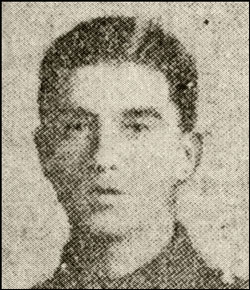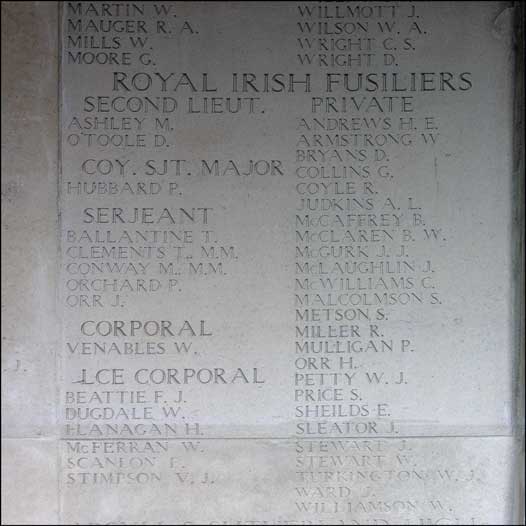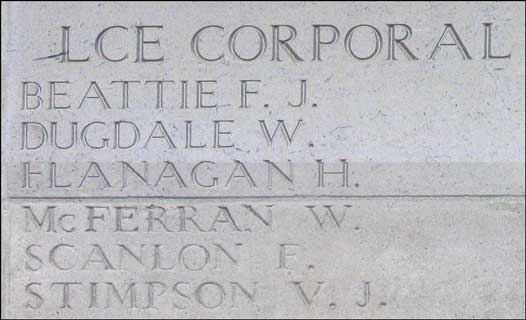![]() In memoriam
In memoriam ![]()
Lance Corporal Hugh Edmond Flanagan

Hugh Edmond Flanagan was born at Alfred Street, Ballymena, County Antrim, on 6 June 1896, the third child of yarn dresser Robert Henry Flanagan and his wife Martha (nee Thompson).
By 1911 the family was living in Dunmurry Town, and a few years later, at 129 Dunluce Avenue, Belfast. At that time Flanagan was working as a teacher in the Ulster Institution for the Education of the Deaf and Dumb and Blind at Lisburn Road, Belfast.
Flanagan enlisted in the North Irish Horse at Antrim between 1 and 3 May 1915 (No.1508). He embarked for France with F Squadron on 17 November that year.
In June 1916 F Squadron joined with C Squadron and the 6th (Inniskilling) Dragoons Service Squadron to form the 2nd North Irish Horse Regiment, serving as corps cavalry to X Corps until August the following year. The regiment was then dismounted and most of its officers and men transferred to the 9th Battalion, Royal Irish Fusiliers – which was renamed the 9th (North Irish Horse) Battalion.
Like most of the men, Flanagan was transferred to the battalion on 20 September. He was issued a new regimental number – 41229.
In November and December 1917 the 9th Battalion played a role in the Battle of Cambrai, first going into action in the attack on the village of Moeuvres on 22-23 November. The battalion war diary for those days reads as follows:
[22 November] The Battn moved up at 6.30 a.m. to a position N. of Bapaume & Cambrai Road arriving at 8.30 a.m. Here the Battn waited for an order to attack Inchi when Moeuvres was taken by the 12th Royal Irish Rifles. At 11.45 a.m. the 12th R. Ir. Rifles captured village of Moeuvres. It was unable to clear trenches East of village. At 5.30 p.m. Battn moved up to support 12th R. Ir. Rifles in the village of Moeuvres. At 5.45 p.m. 12th R. Ir. Rifles reported driven out of village. At 8.30 p.m. Battn less 'D' Coy counter attacked village of Moeuvres but was driven back to trenches immediately south of the village, where it took up a defensive position for the night.
[23 November] Battn attacked Moeuvres at 10.30 a.m. At 11 a.m. Battn reported in village. At 11.45 a.m. enemy counter attacked from trenches West of village. 12.15 p.m. counter attack driven off. At 4.30 .p.m village evacuated by Battn on account of supports not coming up. 5 p.m. 'C' & 'D' Coys took up position on Sunken Road South of village and 'A' & 'B' Coys went back to trenches North of Bapaume & Cambrai Road.
Casualties for 22nd & 23rd: Officers killed 1. Officers wounded 6. ORs 82 casualties.
Flanagan was one of the 82 casualties. Initially reported as wounded and missing, nothing further was heard of him, and a year later he was officially presumed to have died 'on or since' 22 November 1917.
As he has no known grave, Lance Corporal Flanagan is commemorated on the Cambrai Memorial, Louverval, France, Panel 10. If his body was recovered by the Germans after the battle, it was probably buried in the German extension to the Moeuvres Communal Cemetery, and after the war re-interred in the British extension, in which lie 263 unidentified casualties.
Both of Flanagan's brothers served during the war. His older brother William Henry Murray Flanagan was killed in action on 13 April 1918 while serving with the 12th Battalion, Royal Irish Rifles. His younger brother, Thomas Jamison Flanagan, served in the Irish Guards.

Memorial images Copyright © Phillip Tardif with all rights reserved as set out in this Use of Material policy. Photograph of Lance Corporal Flanagan from Nick Metcalfe's Blacker's Boys.

